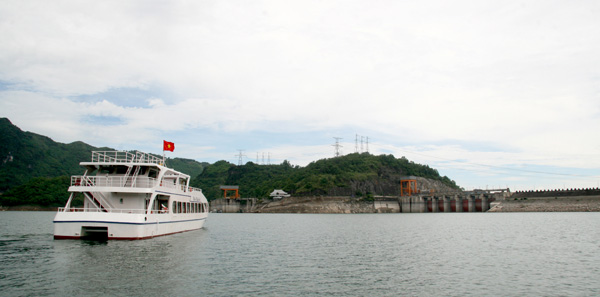
(HBO) – Hoa Binh hydropower plant has become a unmissable destination of any exploration boat trip along the Da River in Hoa Binh province. The plant is indelibly etched on tourists’ minds with powerful generation turbines, while a traditional house keeping a century letter sent to future generations, a President Ho Chi Minh statue and a memorial statue memorising Vietnamese and Russian experts who died during the plant construction give them a deep insight into historical values of the plant.

Hoa Binh hydropower plant is
part of the Da River tour
The granite statue of President Ho Chi Minh,
18 metre in height and
over 400 tonnes in weight, was placed on the top of Tuong Hill in the Hoa Binh
hydropower plant complex. It looks like Uncle Ho is watching local officials
and people making concerted efforts to build a prosperous Hoa Binh province.
From the statue, which is
128
metres above sea level, visitors can enjoy a picturesque
landscape of the giant hydropower plant, immense Hoa Binh reservoir, and afar
distant mountain ranges.
Paying tribute to the late President reminds visitors of a time in 1960 when
taking a boat trip on the Da River, President Ho Chi Minh said that the river
must be conquered to bring long-term benefits to people. And his wish came
true.
In the past decades, Hoa Binh hydropower plant has been consistently generating
power for the country’s renovation process.
To realise the Party and Government’s "electrification” orientation, tens of
thousands of officers, engineers and workers had made tireless efforts to race
against time to complete the construction of the plant. The region was once
teeming with emulation slogans and streaming national flags. It was crowded
with transporters bringing goods, rocks and building materials around the clock.
Trans-mountain tunnels, hundreds of metres in depth, were built on time. Million
tonnes of soils and stones were dug and gathered for blocking the river. Great
endeavors had been made and even blood was shed for the national electricity.
The eight-turbine Hoa Binh hydropower plant with total designed capacity of
1,920 MW became operational and connected with the national grid on December
20, 1994. The plant manifests the sacrifice and industriousness of officers and
experts from
Russia.
168 Russian officials, workers, and experts laid down their lives during the
construction of the plant, making it a symbol of great Vietnam-Russia
friendship relations.
Today,
officers and engineers from the Hoa Binh Hydropower Plant Company are making constant
efforts to manage the plant and generate over 200 billion kWh of electricity for
the national grid, making contributions to the nation’s industrialisation and
modernisation./.
Le Chung
With an increasingly vibrant and widespread emulation movement aimed at building cultured residential areas and cultured families, Yen Thuy District has been making steady progress toward improving both the material and spiritual well-being of its people, while fostering a civilized, prosperous, beautiful, and progressive community.
Once lacking recreational spaces and community facilities, Residential Group 2 in Quynh Lam Ward (Hoa Binh City) has recently received attention for the construction of a new, spacious, and fully equipped cultural house. The project followed the model of state support combined with public contributions in both labor and funding.
The "All people unite to build cultural life" movement, which has been effectively integrated with Kim Boi district’s socio-economic development goals, is fostering a lively spirit of emulation across local residential areas, hamlets, villages, public agencies, and enterprises. In addition, through the initiative, traditional cultural values are being preserved and promoted, while community solidarity and mutual support in poverty reduction and economic development are being strengthened.
A working delegation of the Hoa Binh provincial People’s Committee led by its Permanent Vice Chairman Nguyen Van Toan on June 11 inspected the progress of a project to build the Mo Muong Cultural Heritage Conservation Space linked to tourism services in Hop Phong commune, Cao Phong district.
Born and growing in the heroic land of Muong Dong, Dinh Thi Kieu Dung, a resident in Bo town of Kim Boi district, in her childhood was nurtured by the sweet lullabies of her grandmother and mother. These melodies deeply imprinted on her soul, becoming an inseparable part of her love for her ethnic group's culture. For over 20 years, this love for her hometown has driven Dung to research, collect, and pass down the cultural values of the Muong people to future generations.
In the final days of May, the Ethnic Art Troupe of Hoa Binh Province organized performances to serve the people in remote, mountainous, and particularly disadvantaged areas within the province. These were not just ordinary artistic shows, but they were the meaningful journeys aimed at spreading cultural values, enhancing the spiritual life of the people and contributing to the preservation of ethnic minority cultural identities.



